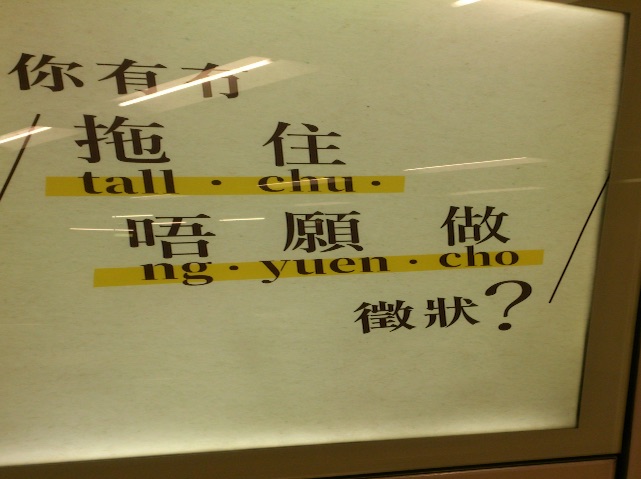Biscriptal ad in the Hong Kong subway
« previous post | next post »
Jenny Chu spotted this ad from a campaign for Nescafe currently being shown in the Hong Kong MTR:
The Jyut Ping for the Chinese characters in the photo is:
nei5 jau5 mou5 to1 zyu6 m4 jyun6 zou6 zing1 zong6
"Do you have the symptoms of procrastinating – of not wanting to work?" (the solution is, of course, to drink coffee).
It's interesting that they provide a partial Romanized transcription, highlighted in yellow, that seems rather ad hoc (not adhering to any established system). Jenny comments:
Obviously this "transcription" has nothing to do with enhancing comprehension. It's not even a very accurate Romanization and might even be a distraction ("tall" for 拖 is an odd choice). Judging from the overall tenor of the ad, it seems rather to be deliberate wordplay for the sake of humor and a coolness factor.
I showed it to a Cantonese-speaking friend who immediately associated it with this fun-with-bad-translation Facebook page. For those who (like me) weren't familiar with this page, I recommend it for some silly laughs.
Bob Bauer offers these additional observations:
Rather than "not wanting to work", I would translate that phrase simply as "unwilling to do anything/something". I'm not sure how to translate "zing1 zong6".
The romanization in the photo is very strange but not at all surprising to me.
"tall" for "to1" is predictable/expected through influence of Cantonese pronunciation on English pronunciation.
Even though Cantonese speakers must be aware that they pronounce the negative morpheme as "m4", they are so fixated on/controlled by the written Chinese character that they hypercorrect its pronunciation to "ng" (even though no one would ever say that in daily speech).
Cf. this earlier ad campaign in the Hong Kong MTR, also sent in by Jenny:
"Multiscript sign in the Hong Kong subway" (12/10/16)

Chaak said,
August 25, 2018 @ 11:35 am
That is how people from my generation would communicate in the ICQ era (i.e late 1990s to early 2000s), when most of us did not know any Chinese input method (Cangjie 倉頡 was the most propulae method at that time, but it takes a month to master). The system is often called Kongish or 港女拼音 gong2neoi2 ping3jam1. It’s a mixture of English similar-sounding words and approximations of Cantonese sound using English spelling rules.
It used to be exfemeley popular among female students from English-medium schools. Not sure how long it took until we found a way to slip in a phrase or two in Cantonese instead of using “pure English”. Not sure about younger people, but people in their 30s or 40s who attended English-medium schools should be familiar with this loose transliteration system, and how much time we spent on deciphering each other’s messages.
I switched to full Cantonese (written in hon3zi6) around 2002-2003, and have stopped using Kongish since then. To me it was a purely transitional thing so I don’t have much feeling. But it does remind me of the good old days back in high school.
There is a popular Facebook page (Kongish Daily 港語日報) dedicated to this transliteration system.
Btw 徵狀 is symptoms.
Jonathan Smith said,
August 25, 2018 @ 3:48 pm
I can't tell from online resources if zing1zong6 徵狀 is a word that would actually be used in spoken Cantonese in contradistinction to zing3zong6 症狀 'symptom'… it seems to have been entered and subsequently deleted from databases like Cantodict.
Chas Belov said,
August 25, 2018 @ 6:56 pm
I'll note that mou5 is one of my favorite colloquial Cantonese characters.
Jerry Friedman said,
August 29, 2018 @ 9:49 am
"Bob Bauer offers these additional observations:
[…]
Even though Cantonese speakers must be aware that they pronounce the negative morpheme as 'm4', they are so fixated on/controlled by the written Chinese character that they hypercorrect its pronunciation to 'ng' (even though no one would ever say that in daily speech)."
A spelling pronunciation in Chinese?